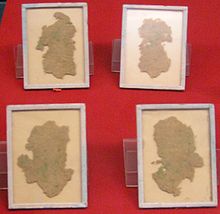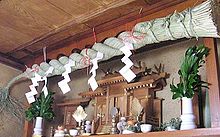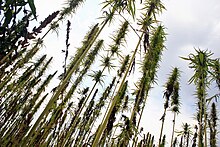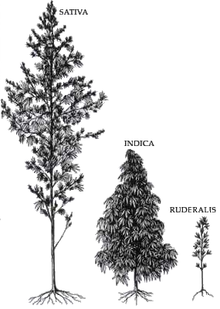Hemp
From Wikipedia, the free encyclopedia
This article is about industrial hemp. For its psychoactive variant, see Cannabis (drug). For the biology of the plant, see Cannabis. For other uses, see Hemp (disambiguation).
| This article has an unclear citation style. (December 2010) |
In modern times hemp is used for industrial purposes including paper, textiles, clothing, biodegradable plastics, construction (as with Hemcrete and insulation), body products, health food and bio-fuel. Hemp is thus legally grown in many countries across the world including Spain, China, Japan, Korea, France, North Africa and Ireland. Although hemp is commonly associated with marijuana (hemp's THC-rich cousin),[2][3][4] since 2007 the commercial success of hemp food products has grown considerably.[5][6]
Hemp is one of the faster growing biomasses known,[7] producing up to 25 tonnes of dry matter per hectare per year.[8] A typical average yield in large scale modern agriculture is about 2.5–3.5 t/ac (air dry stem yields of dry, retted stalks per acre at 12% moisture). Approximately one tonne of bast fiber and 2–3 tonnes of core material can be decorticated from 3–4 tonnes of good quality, dry retted straw.[9][10]
Hemp is very environmentally friendly as it requires few pesticides and no herbicides. It has been called a carbon-negative raw material.[11][12] Results indicate that high yield of hemp may require high total nutrient levels (field plus fertilizer nutrients) similar to a high yielding wheat crop.[13]
The world leading producer of hemp is China with smaller production in Europe, Chile and North Korea.[16] While more hemp is exported to the United States than to any other country, the United States Government does not consistently distinguish between marijuana and the non-psychoactive Cannabis used for industrial and commercial purposes.[15]
Contents[hide] |
[edit] Uses
[edit] Food
Hemp seeds can be eaten raw, ground into a meal, sprouted, made into hemp milk (akin to soy milk), prepared as tea,[19] and used in baking. The fresh leaves can also be consumed in salads. Products include cereals, frozen waffles, hemp tofu, and nut butters. A few companies produce value added hemp seed items that include the seed oils, whole hemp grain (which is sterilized by law in the United States, where they import it from China and Canada), dehulled hemp seed (the whole seed without the mineral rich outer shell), hemp flour, hemp cake (a by-product of pressing the seed for oil) and hemp protein powder. Hemp is also used in some organic cereals, for non-dairy milk[20] somewhat similar to soy and nut milks, and for non-dairy hemp "ice cream."Within the UK, the Department for Environment, Food and Rural Affairs (Defra) has treated hemp as purely a non-food crop. Seed appears on the UK market as a legal food product, and cultivation licenses are available for this purpose. In North America, hemp seed food products are sold, typically in health food stores or through mail order. The United States Department of Agriculture estimates that "the market potential for hemp seed as a food ingredient is unknown. However, it probably will remain a small market, like those for sesame and poppy seeds."[21]
[edit] Nutrition
| Typical nutritional analysis of hulled hemp seeds[22] | |
|---|---|
| Calories/100 g | 567 kcal |
| Protein | 30.6 |
| Carbohydrate | 10.9 |
| Dietary fiber | 6.0 |
| Fat | 47.2 |
| Saturated fat | 5.2 |
| Palmitic 16:0 | 3.4 |
| Stearic 18:0 | 1.5 |
| Monounsaturated fat | 5.8 |
| Oleic 18:1 (Omega-9) | 5.8 |
| Polyunsaturated fat | 36.2 |
| Linoleic 18:2 (Omega-6) | 27.6 |
| Linolenic 18:3 (Omega-3) | 8.7 |
| Gamma-Linolenic 18:3 (Omega-6) | 0.8 |
| Cholesterol | 0 mg |
| Moisture | 4.7 |
| Ash | 6.6 |
| Vitamin A (B-Carotene) | 4.0 IU/100g |
| Thiamine (Vit B1) | 1.4 mg |
| Riboflavin (Vit B2) | 0.3 mg |
| Pyridoxine (Vit B6) | 0.1 mg |
| Vitamin C | 1.0 mg |
| Vitamin E | 9.0 IU/100g |
| Sodium | 9.0 mg |
| Calcium | 74.0 mg |
| Iron | 4.7 mg |
Hempseed's amino acid profile is close to "complete" when compared to more common sources of proteins such as meat, milk, eggs and soy.[23] Hemp protein contains all 21 known amino acids, including the 9 essential ones adult bodies cannot produce. Proteins are considered complete when they contain all the essential amino acids in sufficient quantities and ratios to meet the body's needs. The proportions of linoleic acid and alpha-linolenic acid in one tablespoon (15 ml) per day of hemp oil easily provides human daily requirements for EFAs.
[edit] Storage
Hemp oil can spontaneously oxidize and turn rancid within a short period of time if not stored properly; it is best stored in a dark glass bottle, in a refrigerator or freezer (its freezing point is –20 °C). Preservatives (antioxidants) are not necessary for high quality oils that are stored properly.[edit] Medicine
| This section requires expansion. (March 2012) |
Main article: Medicinal cannabis
Hemp oil has anti-inflammatory properties.[24][edit] Fiber
Hemp fiber was widely used throughout history. Items ranging from rope, to fabrics, to industrial materials were made from hemp fiber. Hemp fiber is a cost effective[citation needed], highly resilient[citation needed], extremely useful product[citation needed]. Its use was virtually eliminated in the United States due to wide ranging marijuana prohibition laws which included hemp in the list of banned substances. Reexamination of why hemp use declined in popularity finds competition with cotton growers and lobbying in Congress led to cotton eclipsing hemp in production.Hemp was often used to make sail canvas, and the word canvas derives from cannabis.[25][26] Today, a modest hemp fabric industry exists, and hemp fibers can be used in clothing.[27] Pure hemp has a texture similar to linen.[28]
[edit] Building material
Main article: hempcrete
Concrete-like blocks made with hemp and lime have been used as an insulating material for construction. Such blocks are not strong enough to be used for structural elements; they must be supported by a brick, wood, or steel frame.[29]The first example of the use of hempcrete was in 1986 in France with the renovation of the Maison de la Turque in Nogent-sur-Seine by the innovator Charles Rasetti.[30] The Renewable House was the UK's first home made from hemp-based materials.[31] Construction was completed in 2009. The first US home made of hemp-based materials was completed in August 2010 in Asheville, North Carolina.[32]
- Concrete block made with hemp in France
[edit] Plastic and composite materials
Main article: hemp plastic
A mixture of fibreglass, hemp fiber, kenaf, and flax has been used since 2002 to make composite panels for automobiles.[5][33] The choice of which bast fiber to use is primarily based on cost and availability. Various car makers are beginning to use hemp in their cars, including Audi, BMW, Ford, GM, Chrysler, Honda, Iveco, Lotus, Mercedes, Mitsubishi, Porsche, Saturn, Volkswagen[34] and Volvo. The Lotus Eco Elise has hemp in it.[35] The Mercedes C-Class has up to 20 kg of hemp in each car.[edit] The Hemp body car
A very popular prototype of a car was made entirely of hemp and soybean plastic, the Hemp body car or Soybean Car, built by Henry Ford in 1941, which was fueled by ethanol, derived from corn.[36][edit] Paper
The first identified coarse paper, made from hemp, dates to the early Western Han Dynasty, two hundred years before the nominal invention of papermaking by Cai Lun, who improved and standardized paper production using a range of inexpensive materials, including hemp ends, approximately 2000 years ago.[37] Recycled hemp clothing, rags and fishing nets were used as inputs for paper production.The Saint Petersburg, Russia paper mill of Goznak opened in 1818. It used hemp as its main input material. Paper from the mill was used in the printing of "bank notes, stamped paper, credit bills, postal stamps, bonds, stocks, and other watermarked paper."[38]
In 1916, U.S. Department of Agriculture chief scientists Lyster Hoxie Dewey and Jason L. Merrill created paper made from hemp pulp and concluded that paper from hemp hurds was "favorable in comparison with those used with pulp wood."[39][40] Modern research has not confirmed the positive finding about hemp hurds. They are only 32% and 38% cellulose.[41] The actual production of hemp fiber in the U.S continued to decline until 1933 to around 500 tons/year. Between 1934-35, the cultivation of hemp began to increase but still at a very low level and with no significant increase of paper from hemp.[42][43]
Hemp has never been used for commercial high-volume paper production due to its relatively high processing cost.[44] Currently there is a small niche market for hemp pulp, for example as cigarette paper.[45] Hemp fiber is mixed with fiber from other sources than hemp. In 1994 there was no significant production of 100% true hemp paper.[46] World hemp pulp production was believed to be around 120,000 tons per year in 1991 which was about 0.05% of the world's annual pulp production volume.[3] The total world production of hemp fiber had in 2003 declined to about 60 000 from 80 000 tons.[45] This can be compared to a typical pulp mill for wood fiber, which is never smaller than 250,000 tons per annum.[46][47] The cost of hemp pulp is approximately six times that of wood pulp,[3] mostly because of the small size and outdated equipment of the few hemp processing plants in the Western world, and because hemp is harvested once a year (during August) and needs to be stored to feed the mill the whole year through. This storage requires a lot of (mostly manual) handling of the bulky stalk bundles. Another issue is that the entire hemp plant cannot be economically prepared for paper production. While the wood products industry uses nearly 100% of the fiber from harvested trees, only about 25% of the dried hemp stem — the bark, called bast — contains the long, strong fibers desirable for paper production.[48] All this accounts for a high raw material cost. Hemp pulp is bleached with hydrogen peroxide, a process today also commonly used for wood pulp.
[edit]
Today, hemp paper for cigarettes, among other things, is produced in Spain and the UK. Around the year 2000, the production quantity of flax and hemp pulp total 25000-30000 tons per year, having been produced from approximately 37000-45000 tonnes fibers. Up to 80% of the produced pulp is used for specialty papers (including 95% of cigarette paper). Only about 20% hemp fiber input goes into the standard pulp area and are here mostly in lower quality (untreated oakum high shive content added) wood pulps. With hemp pulp alone, the proportion of specialty papers probably at about 99%. The market is considered saturated with little or no growth in this area.[49][50][edit] Jewelry
Main article: Hemp jewelry
Hemp jewelry is the product of knotting hemp twine through the practice of macramé. Hemp jewelry includes bracelets, necklaces, anklets, rings, watches and other adornments. Some jewelry features beads made from glass, stone, wood and bones. The hemp twine varies in thickness and comes in a variety of colors. There are many different stitches used to create hemp jewelry, however, the half knot and full knot stitches are most common.[edit] Cordage
Hemp rope was used in the age of sailing ships, though the rope had to be protected by tarring, since hemp rope has a propensity for breaking from rot, as the capillary effect of the rope-woven fibers tended to hold liquid at the interior, while seeming dry from the outside.[51] Tarring was a labor-intensive process, and earned sailors the nickname "Jack Tar". Hemp rope was phased out when Manila, which does not require tarring, became widely available. Manila is sometimes referred to as Manila hemp, but is not related to hemp; it is abacá, a species of banana.[edit] Animal bedding
Hemp shives are the core of the stem, hemp hurds are broken parts of the core. In the EU, they are used for animal bedding (horses, for instance), or for horticultural mulch.[52] Industrial hemp is much more profitable if both fibers and shives (or even seeds) can be used.[edit] Water and soil purification
Hemp can be used as a "mop crop" to clear impurities out of wastewater, such as sewage effluent, excessive phosphorus from chicken litter, or other unwanted substances or chemicals. Eco-technologist Dr. Keith Bolton from Southern Cross University in Lismore, New South Wales, Australia, is a leading researcher in this area. Hemp is being used to clean contaminants at the Chernobyl nuclear disaster site. This is known as phytoremediation - the process by the cleaning radiation as well as a variety of other toxins from the soil, water, and air.[53][edit] Weed control
Main article: Weed control#Organic methods
[edit] Fuel
Biofuels, such as biodiesel and alcohol fuel, can be made from the oils in hemp seeds and stalks, and the fermentation of the plant as a whole, respectively. Biodiesel produced from hemp is sometimes known as "hempoline".[55]Filtered hemp oil can be used directly to power diesel engines. In 1892, Rudolf Diesel invented the diesel engine, which he intended to fuel "by a variety of fuels, especially vegetable and seed oils, which earlier were used for oil lamps, i.e. the Argand lamp."[56][57][58]
Production of vehicle fuel from hemp is very small. Commercial biodiesel and biogas is typically produced from cereals, coconuts, palmseeds and cheaper raw materials like garbage, wastewater, dead plant and animal material, animal feces and kitchen waste.[59]
[edit] Cultivation
Hemp is usually planted between March and May in the northern hemisphere, between September and November in the southern hemisphere.[60] It matures in about three to four months. Millennia of selective breeding have resulted in varieties that look quite different. Also, breeding since circa 1930 has focused quite specifically on producing strains which would perform very poorly as sources of drug material. Hemp grown for fiber is planted closely, resulting in tall, slender plants with long fibers.[citation needed] Ideally, according to Britain's Department for Environment, Food and Rural Affairs, the herb should be harvested before it flowers. This early cropping is done because fiber quality declines if flowering is allowed and, incidentally, this cropping also pre-empts the herb's maturity as a potential source of drug material.[citation needed] However, in these strains of industrial hemp the tetrahydrocannabinol (THC) content would have been very low, regardless.The seeds are sown from mid April to mid May with grain drills to 4–6 cm sowing depth. Hemp needs less fertilizer than corn does. A total of 60–150 kg of nitrogen, 40–140 kg phosphorus (P2O5) and 75–200 kg of potassium [5] per acre for hemp fiber made before sowing and again later, maybe three to four weeks . When practiced, especially in France double use of fiber and seed fertilization with nitrogen doses up to 100 kg / ha rather low. Organic fertilizers such as manure can utilize industrial hemp well. Neither weeds nor crop protection measures are necessary.[citation needed]
[edit] Harvesting
Smallholder plots are usually harvested by hand. The plants are cut at 2 to 3 cm above the soil and left on the ground to dry. Mechanical harvesting is now common, using specially adapted cutter-binders or simpler cutters.The cut hemp is laid in swathes to dry for up to four days. This was traditionally followed by retting, either water retting (the bundled hemp floats in water) or dew retting (the hemp remains on the ground and is affected by the moisture in dew, and by molds and bacterial action). Modern processes use steam and machinery to separate the fiber, a process known as thermomechanical pulping.
[edit] Location and crop rotation
For profitable hemp farming, particularly deep, humus-rich, nutrient-rich soil with controlled water flow is preferable. Water logged acidic, compressed or extremely light (sandy) soils primarily affect the early development of plants. Steep slopes and high altitudes of more than 400 m above sea level are best avoided. Hemp is relatively insensitive to cold temperatures and can withstand frost down to -5 degrees C. Seeds can germinate down to 1-3 degrees. Hemp needs a lot of heat, so earlier varieties come to maturation. The water requirement is 300-500 l / kg dry matter is relatively high, up to 3 feet growing roots into the soil can also use water supplies from deeper soil layers.Hemp benefits crops grown after it. For this reason it is generally grown before winter cereals. Advantageous changes are high weed suppression, soil loosening by the large hemp root system and the positive effect on soil tilth. Since hemp is very self-compatible, it can also be grown several years in a row in the same fields (monoculture).
[edit] Historical cultivation
In Western Europe, nobody banned the cultivation of hemp in the 1930s but the commercial cultivation ceased almost anyhow in the decades after the 1930s. Hemp was simply ousted by artificial fibres.[62]
[edit] Soviet Union
From the 1950s to the 1980s, the Soviet Union was the world's largest producer (3,000 km² in 1970). The main production areas were in Ukraine,[63] the Kursk and Orel regions of Russia, and near the Polish border. Since its inception in 1931, the Hemp Breeding Department at the Institute of Bast Crops in Hlukhiv (Glukhov), Ukraine, has been one of the world's largest centers for developing new hemp varieties, focusing on improving fiber quality, per-hectare yields, and low THC content.[64][65][edit] Japan
[edit] Portugal
The cultivation of hemp in Portuguese lands began around the fourteenth century onwards, it was raw material for the preparation of rope and plugs for the Portuguese ships. Colonies for factories for the production of flax hemp, such as the Royal Flax Hemp Factory in Brazil .After the Restoration of Independence in 1640, in order to recover the ailing Portuguese naval fleet, were encouraged its cultivation as the Royal Decree of D. John IV in 1656 . At that time its cultivation was carried out in Trás-os-Montes, Zone Tower Moncorvo, more precisely in Vilariça Valley, fertile land for any crop irrigation, and a very large area, flat and very fertile culture still wide until the last century grew up tobacco, a plant that needs a large space to expand and grow, the area lies in the valley of Serra de Bornes.
As of 1971, this cultivar is considered illegal because of marijuana, a decision subsequently revoked by the European Union.[citation needed][clarification needed]
[edit] Yield in modern agriculture
FAO argue that an optimum yield of hemp fiber is more than 2 tonnes per ha, while average yields are around 650 kg/ha.[16]
There are a lot of very uncertain, easily misleading and sometimes clearly incorrect numbers about the yield from hemp in ton/hectare or pounds/acre etc. on the Internet. Frequently it is not specified if the numbers describe: the total biomass; the total yield of biomass; the total yield of dried stalk; or the total yield of fiber from the bark. Furthermore, it is frequently not specified whether the numbers measure wet or dry material. Hemp can contain a lot of water. [68] In modern industrial agriculture is about 42% of the plants' biomass returned to the soil in the form of leaves, roots and tops.[9]
[edit] Varieties
A total of 41 varieties of hemp with low levels of tetrahydrocannabinol (THC) are certified by the European Union (EU).[69] They have, unlike other types, a very high fiber content of 30-40%. In contrast to cannabis for medical use, varieties grown for fiber and seed have less than 0.2% THC and they are unsuitable for producing hashish and marijuana.[70] The most important cannabinoid in industrial hemp is cannabidiol (CBD) with a proportion of 1 to 5%.- Varieties primarily cultivated for their fiber, characterized by long stems and little branching, extreme red, yellow, blue or purple coloration, or thickness of stem and solid core, such as hemp Cannabis oglalas, and more generally called industrial hemp.
- Varieties grown for hemp seed oil which is high in protein and essential fatty acids and has no psychoactive properties.
- Varieties grown for medicinal, spiritual or recreational purposes.
[edit] Diseases
Main article: List of hemp diseases
Hemp plants can be vulnerable to various pathogens, including bacteria, fungi, nematodes, viruses and other miscellaneous pathogens. Such diseases often lead to reduced fiber quality, stunted growth, and death of the plant. These diseases rarely affect the yield of a hemp field, so hemp production is not traditionally dependent on the use of pesticides.[edit] History
Yangshao culture (ca. 4800 BCE) amphora with impressed hemp cord design
Má, the Mandarin word for hemp. In Taiwan, the use of hemp has been shown to go back at least 10,000 years.[71]
The classical Greek historian Herodotus (ca. 480 BC) reported that the inhabitants of Scythia would often inhale the vapors of hemp-seed smoke, both as ritual and for their own pleasurable recreation.[73]
Textile expert Elizabeth Wayland Barber summarizes the historical evidence that Cannabis sativa, "grew and was known in the Neolithic period all across the northern latitudes, from Europe (Germany, Switzerland, Austria, Romania, the Ukraine) to East Asia (Tibet and China)," but, "textile use of Cannabis sativa does not surface for certain in the West until relatively late, namely the Iron Age."[74] "I strongly suspect, however, that what catapulted hemp to sudden fame and fortune as a cultigen and caused it to spread rapidly westwards in the first millennium B.C. was the spread of the habit of pot-smoking from somewhere in south-central Asia, where the drug-bearing variety of the plant originally occurred. The linguistic evidence strongly supports this theory, both as to time and direction of spread and as to cause."[75]
Jews living in Palestine in the 2nd century were familiar with the cultivation of hemp, as witnessed by a reference to it in the Mishna (Kil'ayim 2:5) as a variety of plant, along with Arum, that sometimes takes as many as three years to grow from a seedling.
In late medieval Germany and Italy, hemp was employed in cooked dishes, as filling in pies and tortes, or boiled in a soup.[76]
Hemp in later Europe was mainly cultivated for its fibers, and was used for ropes on many ships, including those of Christopher Columbus. The use of hemp as a cloth was centered largely in the countryside, with higher quality textiles being available in the towns.
The Spaniards brought hemp to the Western Hemisphere and cultivated it in Chile starting about 1545.[77] However, in May 1607, "hempe" was among the crops Gabriel Archer observed being cultivated by the natives at the main Powhatan village, where Richmond, Virginia is now situated;[78] and in 1613, Samuell Argall reported wild hemp "better than that in England" growing along the shores of the upper Potomac. As early as 1619, the first Virginia House of Burgesses passed an Act requiring all planters in Virginia to sow "both English and Indian" hemp on their plantations.[79] The Puritans are first known to have cultivated hemp in New England in 1645.[77]

United States "Marihuana" production permit. In the United States, hemp cultivation is legally prohibited, but during World War II farmers were encouraged to grow hemp for cordage, to replace Manila hemp previously obtained from Japanese-controlled areas. The U.S. government produced a film explaining the uses of hemp, called Hemp for Victory.
Hemp was used extensively by the United States during World War II. Uniforms, canvas, and rope were among the main textiles created from the hemp plant at this time.[80] Much of the hemp used was cultivated in Kentucky and the Midwest.
Historically, hemp production had made up a significant portion of antebellum Kentucky's economy. Before the American Civil War, many slaves worked on plantations producing hemp.[81]
During World War II, the U.S. produced a short 1942 film, Hemp for Victory, promoting hemp as a necessary crop to win the war.
By the early twentieth century, the advent of the steam engine and the Diesel engine ended the reign of the sailing ship. The production of iron and steel for cable and ships' hulls further eliminated natural fibres in marine use. Hemp had long since fallen out of favour in the sailing industry in preference to Manila hemp.
[edit] Producers
The world-leading producer of hemp is China, with smaller production in Europe, Chile and North Korea. Over thirty countries produce industrial hemp, including Australia, Austria, Canada, Chile, China, Denmark, Egypt, Finland, France, Germany, Great Britain, Hungary, India, Italy, Japan, Korea, Netherlands, New Zealand, Poland, Portugal, Romania, Russia, Slovenia, Spain, Sweden, Switzerland, Thailand, Turkey and Ukraine.[82][83]The United Kingdom, and Germany all resumed commercial production in the 1990s. British production is mostly used as bedding for horses; other uses are under development. Companies in Canada, the UK, the United States and Germany, among many others, process hemp seed into a growing range of food products and cosmetics; many traditional growing countries still continue to produce textile-grade fibre.
[edit] Australia
In the Australian states of Victoria, Queensland and, most recently, New South Wales, the state governments have issued licences to grow hemp for industrial use. The state of Victoria was an early adopter in 1998, and has reissued the regulation in 2008.[84]| Hemp production in tonnes 2003–2004 FAOSTAT (FAO) | |||||
| 23000 | 79 % | 24000 | 79 % | ||
| 4300 | 15 % | 4300 | 14 % | ||
| 1250 | 4 % | 1250 | 4 % | ||
| 200 | 1 % | 300 | 1 % | ||
| 150 | 1 % | 150 | < 1 % | ||
| 150 | 1 % | 150 | < 1 % | ||
| 100 | < 1 % | 100 | < 1 % | ||
| 40 | < 1 % | 40 | < 1 % | ||
| 15 | < 1 % | 15 | < 1 % | ||
| 8 | < 1 % | 8 | < 1 % | ||
| 2 | < 1 % | 2 | < 1 % | ||
| Total | 29215 | 100 % | 30315 | 100 % | |
[edit] Canada
Commercial production (including cultivation) of industrial hemp has been permitted in Canada since 1998 under licenses and authorization issued by Health Canada (9,725 ha in 2004, 5450 ha in 2009).[89][90][edit] France
[edit] Russia
| This section requires expansion. (August 2012) |

















































No comments:
Post a Comment